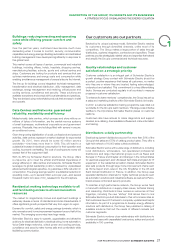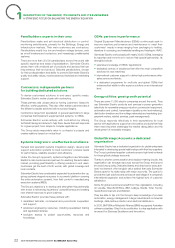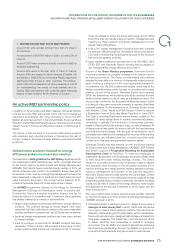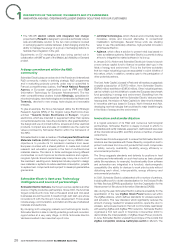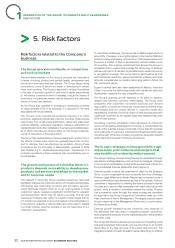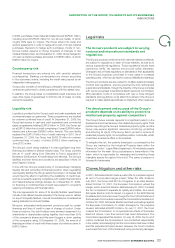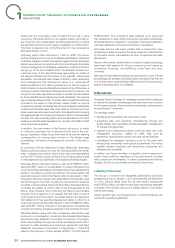APC 2009 Annual Report Download - page 27
Download and view the complete annual report
Please find page 27 of the 2009 APC annual report below. You can navigate through the pages in the report by either clicking on the pages listed below, or by using the keyword search tool below to find specific information within the annual report.
2009 REGISTRATION DOCUMENT SCHNEIDER ELECTRIC 25
DESCRIPTION OFTHEGROUP, ITSMARKETS ANDITSBUSINESSES
1
INNOVATION AND R&D: CREATING INTELLIGENT ENERGY SOLUTIONS FOROURCUSTOMERS
>INNOVATION AND R&D: FACTS AND FIGURES
Around 100 units divided among more than 70 sites in
25 countries.
An investment of EUR764 million in 2009, or nearly 5%of
revenue.
Around 7,500 team members directly involved in R&D or
technical engineering.
Around 42% work in Europe, 25% of them in France.
Another 28% are located in North America (Canada, US
and Mexico), while 28% are in the Asia-Pacifi c region and
slightly less than 2% are in other countries. This division,
which mirrors the breakdown of Group revenue, is critical
for understanding the needs of local markets and for
forging R&D partnerships with potential game-changing
players in Asia-Oceania, North America or Europe.
An active R&D partnership policy
In addition to its innovation and R&D initiatives, Schneider Electric
pursues an active R&D partnership policy with such prestigious
institutions as Shanghai Jiao Tong University in China; the MIT
Media Lab and Georgia Tech in the United States; École des Mines
ParisTech, Institut National Polytechnique de Grenoble and Université
Joseph Fourier in France; and Monterrey Institute of Technology in
Mexico.
The Group is also involved in numerous collaborative projects
with academic and industrial partners in France and the rest of
Europe, notably in the areas of energy effi ciency and environmental
protection.
Collaborative projects focused on energy
efficiency and environmental protection
One example is a testing platform for LED lighting developed within
the collaborative LEDS Habitat project, which is partially fi nanced
by the French Agency for Environment and Energy Management
(ADEME). Test results reveal potential energy savings of 50%, as
well as enhanced user comfort, but installation issues have yet to
be resolved. A new zone-by-zone lighting management concept has
been developed in response to feedback from electricians and end
users involved in the project. The concept will be tested in 2010,
notably at Schneider Electric’s Hotels skills centre in Dubai.
The HOMES programme (Homes and buildings for Optimised
Management of Energy and Services) is now in its second year.
Financed by France’s Industrial Innovation Agency and led by
Schneider Electric in cooperation with 13 partners, the programme
has already chalked up a number of achievements:
•target building categories have been defi ned for energy effi ciency
solutions. The potential savings for these targets have been
estimated and their positioning in relation to the main sustainable
building certifi cation systems (such as LEED) has been evaluated;
•technical energy management architectures have been defi ned
for these buildings;
•a set of prototype components for HOMES solutions has been
developed. These include a self-powered autonomous comfort
sensor, smart sockets that can be controlled in on/off or “dimmer”
mode via wireless or power line carrier technology, and an Offi ce
Room Box that can handle energy protection, management and
metering for HVAC systems and shade management for a 50
square-meter offi ce space;
•a list of 80 energy management functions has been compiled
for testing in different situations. Simulations will be conducted in
2010 and on-site testing in buildings will be done for the functions
that show the greatest potential;
•seven validation platforms have been set up at CEA-INES, CIAT,
CSTB, EDF and Schneider Electric covering various aspects of
use, interoperability, energy effi ciency and comfort.
As part of the Green Plastics programme , Schneider Electric
is pursuing research on possible changes in the plastics used in
its electrical products. The Group is collaborating with partners
selected for their skills on a number of strategically related projects,
each of which is carried out in the most appropriate framework.
For example, the VALEEE collaborative project under way at the
Axelera competitiveness cluster focuses on recycling and re-using
plastics. As part of this project, Schneider Electric and customer
ERDF are determining which plastics should be recycled fi rst and
which recycled plastics could be used as substitute products. The
Group is also involved in the European Multihybrids project, which
is looking at using nanocomposite materials to replace other fl ame
retardant systems. On the academic front, Schneider Electric joined
with Arkema, L’Oréal, Nestlé and PSA Peugeot Citroën to support
a Bioplastics Chair at École des Mines ParisTech in June2009.
The Chair is providing fi nancing for several theses, notably on the
feasibility of using natural fi bers to replace conventional plastics,
completely or partially. The introduction of biosourced polymers,
based on Play Lactic Acid for example, is also our area of research. All
of these projects take safety into account at both the manufacturing
and fi nished product stages, with the goal of reducing the use of
potentially toxic materials and managing their recovery while ensuring
that products can withstand heat, fi re, corrosion and other harsh
conditions so that users are guaranteed optimum safety.
Schneider Electric has also teamed up with the French Agency
for Environment and Energy Management (ADEME), EDF, Renault
and Total to support a Prospective Modeling for Sustainable
Development Chair at ParisTech. To meet the challenges of
sustainable development, both businesses and public offi cials need
to think long-term when making strategic choices. The Chair’s
mission is to provide common tools for decision makers, experts
and scientists while focusing on the articulation between short,
medium and long-term needs and the interface between business,
resource management and climate. In line with this approach,
Schneider Electric opened a side event at the Copenhagen Climate
Change Conference on the relationship between regional energy
policies and global carbon emission constraints. Ultimately, modeling
results should make it clearer which energy effi ciency technologies
and applications are the best investment in which region over the
short and long-term.
Two new collaborative projects approved and partially fi nanced
by the French Agency for Environment and Energy Management
(ADEME) will begin in 2010.
•Schneider Electric is leading a project to design and produce a
new type of solar power plant in which 10kW units will use the
sun’s rays to heat a thermodynamic machine that can drive an
alternator. Unlike existing photovoltaic plants, which use batteries,
these units will use an eco-designed heat storage unit made from
local green materials. This project fi ts in with the Group’s efforts
to deliver electricity from renewables to people in emerging
economies. The ten SMEs and research laboratories partnering
the project are participating through the BipBop programme to
provide their technical skills and gain access to new markets.








